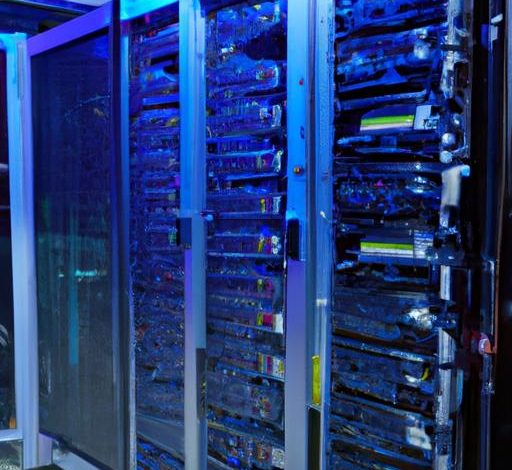What is Data Replication? A Crucial Component of Modern Technology

In today’s fast-paced digital world, the sheer volume of data generated is staggering. From business transactions to personal information, the need to efficiently manage and safeguard this data has become paramount. This is where data replication comes into play. But what exactly is data replication and why is it so crucial in modern technology?
A. Definition of data replication
Data replication refers to the process of creating and maintaining multiple copies of data across different locations or systems. It involves duplicating and synchronizing data to ensure it is consistently available and up-to-date. By replicating data, organizations can enhance data accessibility, improve performance, and mitigate the risk of data loss.
B. Importance of data replication in modern technology
In an era where downtime can have severe consequences, data replication has emerged as an essential component of modern technology. By replicating data, organizations can achieve high availability and ensure uninterrupted access to critical information. Whether it’s a sudden hardware failure, natural disaster, or cyberattack, data replication provides a safety net, enabling businesses to quickly recover and resume operations.
Moreover, data replication plays a pivotal role in improving data integrity and reliability. By distributing copies of data across multiple systems, organizations can minimize the risk of data corruption or loss. This redundancy ensures that even if one copy becomes compromised, the other copies remain intact and accessible.
Additionally, data replication facilitates load balancing, enabling efficient distribution of data across various systems. With replicated data, organizations can optimize performance and enhance user experience by directing requests to the nearest or least congested server. This not only improves response times but also ensures consistent performance, even during peak usage periods.
In summary, data replication is a vital tool that empowers organizations to safeguard their data, enhance availability, and optimize performance. As we delve deeper into this topic, we will explore the intricacies of data replication, its benefits, and the challenges organizations face in implementing it effectively. So, join me on this journey to unravel the world of data replication and its significance in modern technology.
How Data Replication Works
Data replication involves a meticulous process that ensures the synchronization and duplication of data across multiple locations or systems. Understanding how this process works is crucial for comprehending the significance of data replication in modern technology.
A. Explanation of the replication process
The replication process typically begins with the selection of a primary data source, often referred to as the master or primary node. This primary node serves as the authoritative source of the data. Any modifications or updates made to the data are initially performed on the primary node.
Once changes are made, the replication process comes into action. The modified data is then transmitted to one or more secondary nodes, which are replicas of the primary node. These secondary nodes receive the changes and synchronize them with their own copies of the data. This ensures that all copies of the data remain consistent and up-to-date.
To achieve synchronization, various techniques and protocols are employed. These include log-based replication, where changes are recorded in a log file and replicated to the secondary nodes, and snapshot-based replication, where periodic snapshots of the entire dataset are taken and replicated to the secondary nodes.
B. Different methods of data replication
Data replication can be implemented using different methods, depending on the specific requirements and constraints of the system. Let’s explore three common methods of data replication:
1. Full data replication
As the name suggests, full data replication involves replicating the entire dataset from the primary node to the secondary nodes. This method ensures that each replica contains an exact copy of the primary data source. While full data replication offers maximum consistency and reliability, it can be resource-intensive and may require substantial bandwidth.
2. Partial data replication
Partial data replication focuses on replicating only a subset of the data, rather than the entire dataset. This approach allows organizations to prioritize critical or frequently accessed data for replication, while excluding less essential or rarely accessed data. Partial data replication can help optimize resources and reduce network bandwidth requirements.
3. Incremental data replication
Incremental data replication involves replicating only the changes or updates made to the data since the last replication. Instead of transmitting the entire dataset, only the modified data is transmitted to the secondary nodes. This method minimizes bandwidth usage and reduces synchronization time, making it a popular choice in scenarios where real-time or near-real-time replication is required.
By understanding the intricacies of the replication process and the different methods available, organizations can tailor their data replication strategies to meet their specific needs. In the next section, we will delve into the benefits that data replication brings to the table, and how it enhances data availability and integrity.
Benefits of Data Replication
Data replication offers a multitude of advantages that are crucial for organizations in today’s data-driven landscape. Let’s explore some of the key benefits that come with implementing data replication strategies.
A. Enhanced data availability and accessibility
Data replication ensures that data is readily available and accessible, even in the face of system failures or disruptions. By creating multiple copies of data across different locations, organizations can reduce the risk of data unavailability. In the event of a server failure or network outage, users can seamlessly access data from alternative sources, ensuring uninterrupted operations. This enhanced availability empowers businesses to deliver consistent services to their customers and avoid costly downtime.
B. Improved data integrity and reliability
Maintaining data integrity and reliability is of utmost importance for organizations. Data replication plays a critical role in achieving this by creating redundant copies of data. With multiple copies, organizations can verify and compare data across different systems, ensuring its accuracy and consistency. This redundancy also acts as a safeguard against data loss or corruption. If one copy becomes compromised, organizations can rely on the other copies to recover the original data, preserving its integrity and reliability.
C. Disaster recovery and business continuity
Disasters can strike at any moment, from natural calamities to cyberattacks. In such scenarios, data replication becomes a lifesaver. By replicating data, organizations can develop robust disaster recovery strategies. In the event of data loss or system disruptions, organizations can swiftly recover by utilizing the replicated data. This enables quick restoration of operations and minimizes the impact on business continuity. Data replication serves as a key pillar in ensuring that organizations can bounce back from unforeseen events without significant disruptions or losses.
D. Load balancing and improved performance
Data replication also contributes to enhanced performance and load balancing. By distributing data across multiple servers or systems, organizations can effectively balance the workload. Requests can be directed to the servers with the least traffic, optimizing response times and avoiding bottlenecks. This load balancing capability ensures that resources are efficiently utilized, leading to improved performance and smoother user experiences.
In conclusion, data replication offers a range of benefits that are indispensable in today’s data-driven world. From enhancing availability and accessibility to improving data integrity and reliability, data replication serves as a valuable tool for organizations. Additionally, it plays a vital role in disaster recovery and business continuity, as well as load balancing to optimize performance. As we move forward, we will delve into the common use cases of data replication and explore how it is applied in various technology environments.
Common Use Cases of Data Replication
As data replication continues to gain prominence, its applications expand across various domains. Let’s explore some of the common use cases where data replication plays a pivotal role:
A. Database replication in enterprise systems
In today’s data-driven world, enterprises rely heavily on databases to store and manage vast amounts of information. Database replication allows organizations to create multiple copies of their databases, ensuring data consistency and availability. This redundancy not only enhances data reliability but also enables organizations to scale their operations and handle increasing workloads efficiently. Furthermore, database replication facilitates disaster recovery and provides failover capabilities, minimizing downtime and ensuring business continuity.
B. Replication in distributed computing environments
Distributed computing environments, where multiple interconnected systems collaborate to solve complex problems, heavily rely on data replication. In such scenarios, data replication enables shared access to data, ensuring consistency and coherence across the distributed systems. This allows for efficient data processing, improved fault tolerance, and enhanced scalability. By replicating data across distributed nodes, organizations can harness the power of parallel computing and distribute computational tasks seamlessly.
C. Replication in cloud computing and high-availability solutions
Cloud computing has revolutionized the way organizations store, process, and access data. Data replication plays a critical role in cloud environments, ensuring high availability and fault tolerance. By replicating data across multiple data centers or regions, cloud service providers can guarantee uninterrupted access to data and services even in the event of hardware failures or natural disasters. This redundancy allows organizations to achieve robust disaster recovery strategies and meet stringent service level agreements (SLAs).
High-availability solutions, designed to minimize downtime and provide uninterrupted access to critical services, heavily rely on data replication. By replicating data in real-time or near real-time, organizations can ensure continuous availability of their applications and services. This is particularly crucial in industries where even a few moments of downtime can result in substantial financial losses or reputational damage.
In conclusion, data replication finds diverse applications in enterprise systems, distributed computing environments, and cloud computing. By understanding these common use cases, organizations can leverage data replication to enhance data availability, improve fault tolerance, and achieve seamless scalability. Join me as we delve deeper into the challenges and considerations associated with data replication in the next section.
Challenges and Considerations in Data Replication
While data replication brings numerous benefits, it also presents certain challenges and considerations that organizations must address to ensure its successful implementation. Let’s explore some of the key challenges associated with data replication and the considerations organizations need to keep in mind.
A. Data consistency and synchronization issues
Maintaining data consistency and synchronization across multiple copies can be a complex task. As data is replicated in real-time or near real-time, organizations must ensure that all copies remain consistent and up-to-date. Synchronization issues can arise due to network delays or system failures, leading to discrepancies between copies of the data. Organizations must implement robust mechanisms to address these challenges and ensure data consistency throughout the replication process.
B. Network bandwidth and latency constraints
Data replication involves the transfer of large volumes of data across networks. Limited bandwidth or high latency can impact the efficiency of data replication, leading to delays and potential data loss. Organizations need to consider network constraints and optimize their infrastructure to handle the increased traffic associated with data replication. Employing compression techniques, bandwidth management tools, and leveraging high-speed networks can help mitigate these challenges.
C. Data security and privacy concerns
Replicating data across multiple locations introduces additional security and privacy considerations. Organizations must ensure that replicated data remains secure and protected from unauthorized access or data breaches. Implementing robust encryption protocols, access controls, and monitoring mechanisms can help safeguard replicated data and maintain data privacy compliance.
D. Cost and resource implications
Data replication can incur significant costs in terms of hardware, network infrastructure, and storage resources. Organizations must carefully evaluate the cost implications associated with data replication and ensure that it aligns with their budgetary constraints. Additionally, managing and maintaining multiple copies of data requires dedicated resources and expertise. Adequate resource allocation and planning are crucial to ensure the successful implementation and maintenance of data replication solutions.
In conclusion, while data replication offers numerous benefits, organizations must navigate through challenges and considerations to ensure its effectiveness. Addressing data consistency, network constraints, security, and resource implications are key to successful data replication implementation. By considering these factors, organizations can harness the power of data replication while mitigating potential risks and maximizing its value.
Conclusion: Embracing Data Replication for a Resilient Future
As we conclude our exploration of data replication, it becomes evident that this technology stands as a crucial pillar in the realm of modern technology. The ability to duplicate and synchronize data across multiple systems has revolutionized the way organizations operate, ensuring high availability, data integrity, and optimal performance.
Recap of the importance and benefits of data replication
Data replication, as defined earlier, involves creating and maintaining multiple copies of data. This redundancy serves as a safety net, mitigating the impact of hardware failures, natural disasters, and cyberattacks. By embracing data replication, businesses can minimize downtime, swiftly recover from disruptions, and guarantee uninterrupted access to critical information.
Moreover, data replication enhances data integrity and reliability. Through the distribution of data across multiple systems, organizations can safeguard against data corruption or loss. This redundancy ensures the preservation of accurate and consistent data, even in the face of unforeseen circumstances.
Data replication also empowers organizations to optimize performance and enhance user experience through load balancing. By replicating data across various systems, organizations can efficiently distribute requests, directing them to the nearest or least congested server. This results in improved response times and consistent performance, even during peak usage periods.
Future trends and advancements in data replication technology
As technology continues to evolve, so does data replication. We can anticipate future advancements that will further enhance its capabilities. For instance, advancements in cloud computing and artificial intelligence are likely to revolutionize data replication, enabling more efficient and intelligent replication strategies.
Additionally, the growing importance of data privacy and security will shape the future of data replication. Organizations will need to implement robust security measures to protect replicated data from unauthorized access or breaches. Encryption, access controls, and secure communication protocols will play a pivotal role in ensuring the confidentiality and integrity of replicated data.
In conclusion, data replication has emerged as a critical aspect of modern technology, empowering organizations to safeguard their data, enhance availability, and optimize performance. By embracing data replication, businesses can navigate the ever-changing technological landscape with resilience and confidence.
Remember, at data.makethatpc.com, we strive to provide you with valuable insights and knowledge to navigate the complex world of data replication and other cutting-edge technologies. Stay tuned for more informative articles and resources to help you stay ahead in the digital era.
Join our community and unlock the true potential of data replication at data.makethatpc.com!
Conclusion: So above is the What is Data Replication? A Crucial Component of Modern Technology article. Hopefully with this article you can help you in life, always follow and read our good articles on the website: data.makethatpc.com




